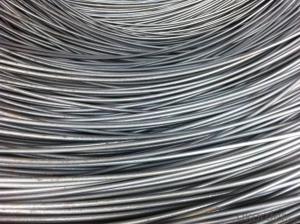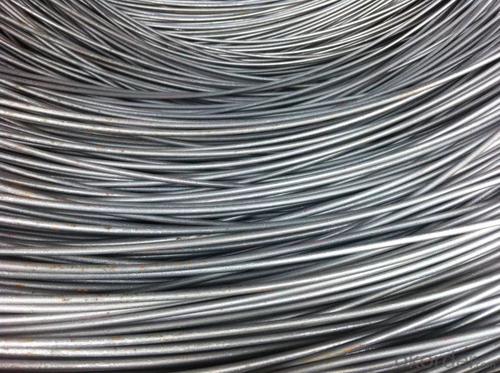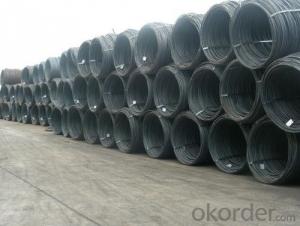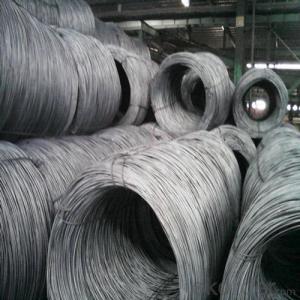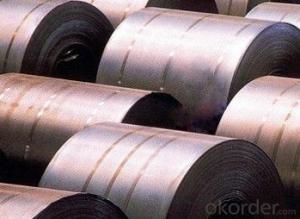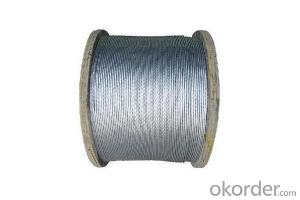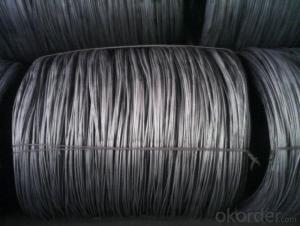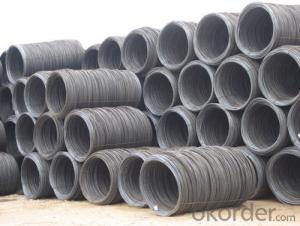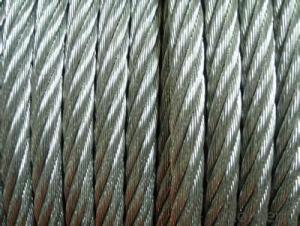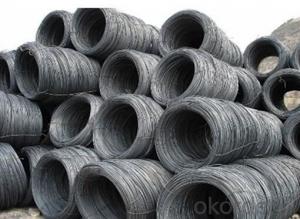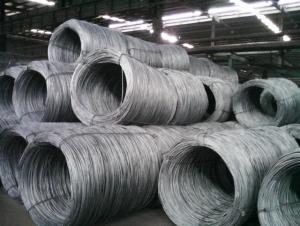Wire Rod Of Mild Steel_8mm
- Loading Port:
- China Main Port
- Payment Terms:
- TT OR LC
- Min Order Qty:
- -
- Supply Capability:
- -
OKorder Service Pledge
OKorder Financial Service
You Might Also Like
Specifications of Steel Wire Rod in Coil:
Steel Grade: Q195/235, SAE1006-1018B Standard: ASTM, GB
Diameter: 6.5mm
Type: Drawn Wire Alloy or Not: Alloy
Technique: Hot Rolled
Usage and Applications of Hot Rolled Wire Rod:
After hotrolled the products shaped into coil and delivery as finished product, including round, square, rectangular, hexagonal and so on. Since most of the products are round, it is generally called wire rod. Carbon steel wire rod is widely used in construction and manufacturing. Carbon steel wire rod is mainly used for reinforcement of reinforced concrete and welded structure or reprocessed (roberts , nail, etc.) materials, especially used to produce wire drawing, welding electrode, nails, spring, electronic, precise machinery parts and so on.
Packaging & Delivery of Hot Rolled Wire Rod:
Packaging Detail: products are packed in coil, each coil weight around 2 MT, and then shipped by container or bulk vessel
Delivery Detail: within 45 days after received deposit or LC.
Label: to be specified by customer, generally, each bundle has 1-2 labels
Trade terms: FOB, CFR, CIF
Note:
1. Our products are produced according to national standard (GB), if not, supply according to national standards (GB) or agreement as customer required.
2. Other Grade and Standard carbon steel wire rod we can supply:
Grade: H08A, 30MnSi, 62B-82B
Standard: AISI, BS, JIS, DIN
The Minimum Order Quantity of these products is high, and need to be confirmed.
3. We can not only supply carbon steel wire rod; if you need anything about building materials, please contact us.
4. Please send us your detail specifications when inquire. We will reply to you as soon as possible. We sincerely hope we can establish a long stable business relationship.
- Q: What are the common types of internal defects in steel wire rod?
- Some common types of internal defects in steel wire rod include inclusions, segregations, cracks, and voids. Inclusions are foreign substances that are trapped within the steel during the manufacturing process. Segregations occur when the composition of the steel is not uniform, resulting in areas with different properties. Cracks can occur due to excessive stress or improper cooling during production. Voids are empty spaces or cavities within the steel. These defects can weaken the wire rod and affect its overall quality and performance.
- Q: What are the standard specifications for steel wire rod?
- The standard specifications for steel wire rod typically include factors such as diameter, tensile strength, chemical composition, and surface condition. These specifications are important for ensuring the quality and performance of the steel wire rod in various applications.
- Q: How is the wear resistance of steel wire rod assessed?
- Assessing the wear resistance of steel wire rod can be done using various methods. One commonly used approach involves conducting the pin-on-disk test. In this test, a steel pin is pressed against a rotating disk made of a different material. The amount of wear experienced by the steel pin is then determined by measuring the weight loss or volume loss after a certain number of rotations. Another method, known as the abrasion test, entails rubbing the steel wire rod against a rough surface and measuring the resulting wear. Furthermore, evaluating the wear resistance of the steel wire rod can also be achieved by subjecting it to realistic conditions, such as within a machine or equipment, and observing its performance over time. These methods serve to gauge the steel wire rod's ability to endure wear and offer invaluable insights for the development and enhancement of products.
- Q: How is steel wire rod used in the production of wire for mattress springs?
- Steel wire rod is a crucial component in the production of wire for mattress springs. It serves as the primary raw material that is used to create the strong and durable wire required for mattress springs. To begin the manufacturing process, steel wire rod is first carefully selected based on its desired properties, such as its tensile strength, flexibility, and resistance to corrosion. The rod is then subjected to a series of processes to transform it into wire suitable for mattress springs. The first step involves heating the steel wire rod and passing it through a series of dies to progressively reduce its diameter. This process, known as wire drawing, helps refine the wire's mechanical properties and ensures uniformity in its thickness. Once the wire has been drawn to the desired diameter, it undergoes further treatment to enhance its strength and resilience. This may involve heat treatment processes like annealing or quenching, which help to improve the wire's flexibility and resistance to fatigue. After the wire has been treated, it is coiled onto spools or reels, ready to be used in the manufacturing of mattress springs. The wire is then fed into specialized spring-making machinery, where it is formed into the required shape and size. These machines use a combination of bending, coiling, and twisting movements to create the intricate spring designs commonly found in mattresses. The high-quality steel wire rod used in the production of wire for mattress springs ensures that the springs are strong, durable, and capable of withstanding the constant pressure and weight applied to them. This results in a mattress that offers excellent support and comfort to the sleeper. In summary, steel wire rod plays a critical role in the production of wire for mattress springs. It undergoes various processes to refine its properties and is then shaped into the required form to create sturdy and resilient springs. This ensures that mattresses made with these springs offer superior support and durability to users.
- Q: How is steel wire rod used in the manufacturing of wire ropes for cranes?
- Steel wire rod is used as the raw material in the manufacturing of wire ropes for cranes. It undergoes a series of processes such as drawing, stranding, and coating to transform it into a strong and durable wire rope. The steel wire rod provides the necessary tensile strength and flexibility required for wire ropes to withstand heavy loads and repetitive lifting movements in crane operations.
- Q: How is steel wire rod used in the manufacturing of wire for springs in mattresses?
- Steel wire rod is an essential raw material used in the manufacturing of wire for springs in mattresses. It serves as the building block for creating sturdy and durable springs. The steel wire rod undergoes a series of processes such as drawing, annealing, and tempering to enhance its strength and flexibility. These processed rods are then coiled and formed into springs, which are ultimately incorporated into the mattresses to provide support and enhance comfort.
- Q: How is the impact resistance of steel wire rod tested?
- The impact resistance of steel wire rod is typically tested using a Charpy impact test. In this test, a notched specimen of the wire rod is subjected to a swinging pendulum that strikes and breaks the specimen. The energy absorbed by the specimen during fracture is measured, which provides an indication of its impact resistance.
- Q: How is steel wire rod used in the production of suspension springs for railway vehicles?
- Steel wire rod is used in the production of suspension springs for railway vehicles as it provides the necessary strength and durability required to support the weight of the vehicles and absorb the shocks and vibrations during train operation. The wire rod is shaped, coiled, and heat-treated to form the suspension springs, which are then installed in the suspension system of railway vehicles to ensure a smooth and stable ride for passengers and cargo.
- Q: What are the different surface defects that can affect the ductility of steel wire rod?
- Some of the different surface defects that can affect the ductility of steel wire rod include cracks, surface roughness, scale, pitting, and surface decarburization. These defects can weaken the material and reduce its ability to stretch or deform without breaking.
- Q: What is the typical chemical composition of steel wire rod?
- The typical chemical composition of steel wire rod can vary depending on the specific grade and intended use of the wire rod. However, the most common chemical composition of steel wire rod includes iron as the main element, along with small amounts of carbon, manganese, phosphorus, sulfur, and silicon. Carbon is an important element in steel wire rod as it provides strength and hardness to the material. Manganese is often added to improve the hardenability and strength of the steel. Phosphorus and sulfur are impurities that are typically minimized as they can negatively affect the properties of the steel. Silicon is added to enhance the steel's deoxidation and improve its resistance to corrosion. It is important to note that different grades of steel wire rod may have varying amounts of these elements, as well as the inclusion of other alloying elements such as chromium, nickel, or molybdenum, which are added to achieve specific properties and characteristics required for different applications.
Send your message to us
Wire Rod Of Mild Steel_8mm
- Loading Port:
- China Main Port
- Payment Terms:
- TT OR LC
- Min Order Qty:
- -
- Supply Capability:
- -
OKorder Service Pledge
OKorder Financial Service
Similar products
Hot products
Hot Searches
Related keywords
